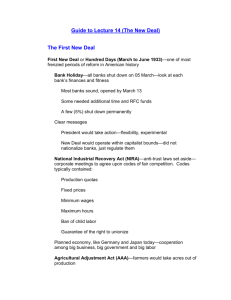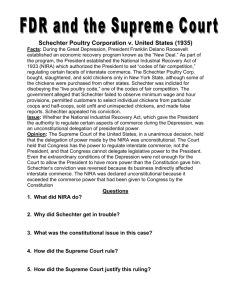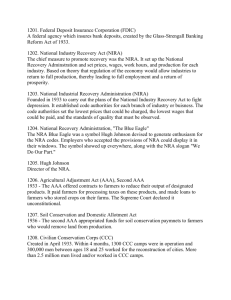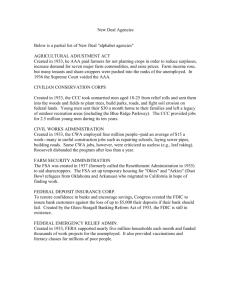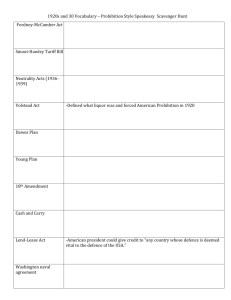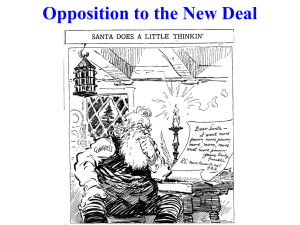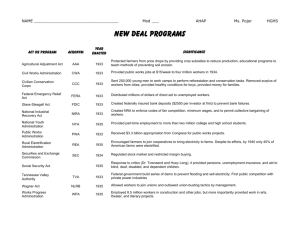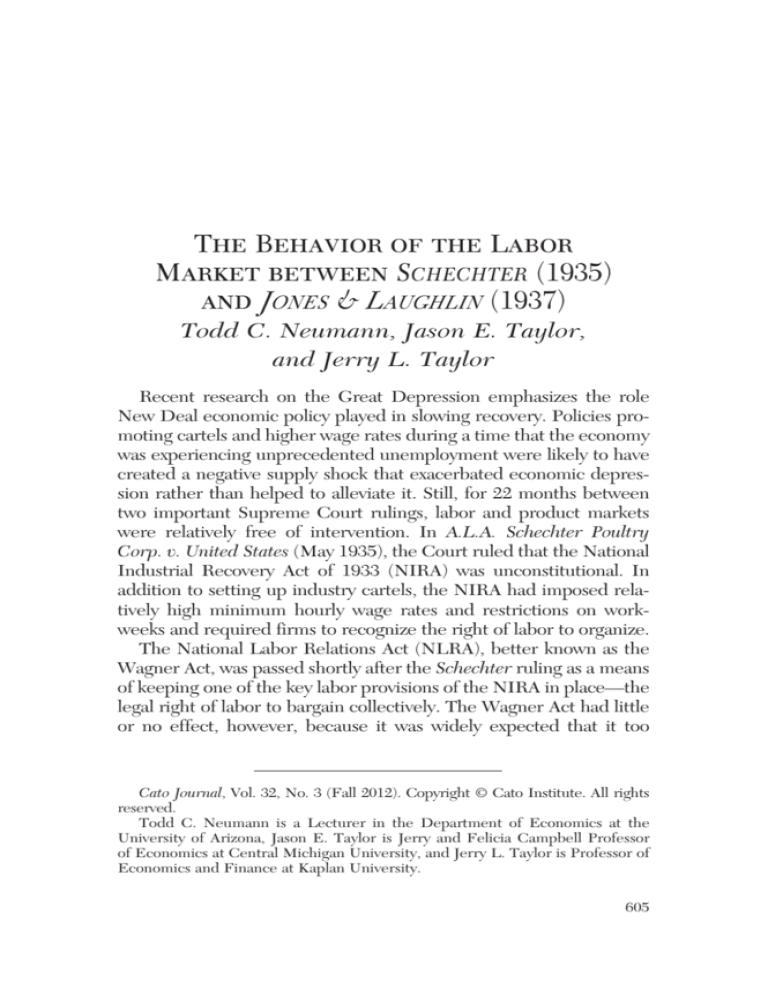
The Behavior of the Labor
Market between SCHECHTER (1935)
and JONES & LAUGHLIN (1937)
Todd C. Neumann, Jason E. Taylor,
and Jerry L. Taylor
Recent research on the Great Depression emphasizes the role
New Deal economic policy played in slowing recovery. Policies promoting cartels and higher wage rates during a time that the economy
was experiencing unprecedented unemployment were likely to have
created a negative supply shock that exacerbated economic depression rather than helped to alleviate it. Still, for 22 months between
two important Supreme Court rulings, labor and product markets
were relatively free of intervention. In A.L.A. Schechter Poultry
Corp. v. United States (May 1935), the Court ruled that the National
Industrial Recovery Act of 1933 (NIRA) was unconstitutional. In
addition to setting up industry cartels, the NIRA had imposed relatively high minimum hourly wage rates and restrictions on workweeks and required firms to recognize the right of labor to organize.
The National Labor Relations Act (NLRA), better known as the
Wagner Act, was passed shortly after the Schechter ruling as a means
of keeping one of the key labor provisions of the NIRA in place—the
legal right of labor to bargain collectively. The Wagner Act had little
or no effect, however, because it was widely expected that it too
Cato Journal, Vol. 32, No. 3 (Fall 2012). Copyright © Cato Institute. All rights
reserved.
Todd C. Neumann is a Lecturer in the Department of Economics at the
University of Arizona, Jason E. Taylor is Jerry and Felicia Campbell Professor
of Economics at Central Michigan University, and Jerry L. Taylor is Professor of
Economics and Finance at Kaplan University.
605
Cato Journal
would be ruled unconstitutional. In April 1937, after President
Franklin D. Roosevelt threatened to pack the Court with six more
judges who would be friendly to his policies, the Court surprisingly
upheld the constitutionality of the NLRA with its 5-4 decision in
National Labor Relations Board v. Jones & Laughlin Steel. A large
wave of union activity followed the ruling and average real hourly
earnings rose dramatically.
Increases in equilibrium wage rates are the desirable by-product
of rising worker productivity, but policy-driven wage increases, such
as those that followed the NIRA and NLRA, would be expected to
exacerbate the unemployment problem in a depressed economy. In
fact, the economy experienced significant recovery between May
1935 and April 1937, only to falter again in the months that followed.
In this article, we perform an empirical analysis to determine
whether the different movements in labor input, output, and real
wage rates between policy regimes persists when controlling for
changes in fiscal and monetary policy. Our results suggest that the
recovery that occurred between Schechter and Jones & Laughlin was
indeed related to the absence of the harmful policies that preceded
and followed those decisions.
The National Industrial Recovery Act
When the NIRA was passed in June 1933, it was hailed by the
Roosevelt administration as the Magna Carta for the American
worker (Johnson [1935] 1968: 239). This moniker primarily followed
from the NIRA’s Section 7(a), which gave workers the right to organize and bargain collectively. In fact, Kaufman (1996) notes that government recognition of organized labor’s rights helped spur the
tripling of union density in the two decades that followed. But the
NIRA was designed by Roosevelt to do more than promote longterm reform through unionization. In the short term, it was hoped
that the legislation would provide workers enhanced employment
opportunities and higher pay through the institution of minimumwage rates and maximum-hour (work-sharing) provisions among
NIRA-covered industries.
The general consensus of economists studying the New Deal is
that despite the long-run gains that the right to collective bargaining
provided to workers, the NIRA was unsuccessful in its short-term
goal of helping labor. Higher hourly wage rates may be viewed as a
606
Behavior of the Labor Market
desirable economic goal during normal economic times, but it was
exactly what the economy did not need with unemployment rates of
20 to 25 percent. Vedder and Gallaway (1993) claim that the persistence of unemployment during the 1930s can be traced to the wageincreasing New Deal policies such as the NIRA and the Wagner Act.
Powell (2003) notes that the high-wage policies embedded in the
NIRA accelerated the substitution of capital for labor and exacerbated the unemployment problem during the 1930s. Cole and
Ohanian (2004) employ a general equilibrium empirical framework
and conclude that the NIRA’s broad labor and cartelization policies
were the key factors that prevented a normal recovery from the
Great Depression. On the less critical side, Bernanke (1986: 106)
claims that the NIRA provisions “had little systematic impact.”
Additionally, Taylor (2011) finds that the work-sharing aspects of the
NIRA’s work-week reductions, when viewed by themselves, created
jobs. However, he shows that these gains were almost entirely wiped
out by the wage increases and cartelization that accompanied the
policy regime. Thus, with regard to its short-term impact on labor,
the general consensus is that the NIRA was neutral at best and, by
raising wage rates in the face of unemployment, was detrimental and
intensified the jobs shortage.
Of course the NIRA affected more than just the labor sector of the
economy. Its dramatic attempt to bring about economic recovery
centered on the cartelization of American industries. Industrial executives were required to meet and agree on “codes of fair competition” under which cartel objectives such as higher prices, product
standardization, and other profit-enhancing limits to competition
could be pursued. Industry cooperation was viewed as having been
largely successful during World War I and was subsequently portrayed as the best hope for recovery from the Great Depression.
Donald Richberg, general counsel of the National Recovery
Administration (NRA) stated that “thousands of businessmen themselves should know better than any small group of lawmakers” what
specific collective efforts would best lead to economic recovery
(Irons 1982: 97).
The NIRA established 765 industry and supplemental codes, each
containing several cartel-oriented provisions. The most common provision—contained in over 400 codes, including those for steel, coal,
newsprint, lead, and woodworking machinery industries—was open
price filing, which required firms to file their prices with the cartel’s
607
Cato Journal
central board and give advance notice, typically between 3 and
7 days, of any change in price. Such a requirement inhibits competition by revealing firms’ pricing policies to rivals. When changes are
instituted, rivals can either match the price or retaliate in other ways
against a price-cutting firm, therefore giving the initial firm less
incentive to change prices in the first place.
Of course, the NIRA cartel provisions went well beyond open
price filing as at least 130 different categories of trade-practice provisions were contained within the NIRA codes (U.S. Committee of
Industrial Analysis 1937: 74). For example, the Boot and Shoe
Manufacturing code dictated that price increases had to accompany
any cost-raising actions such as the use of special shoe boxes or labels
(Article 8, Section 4). The Iron and Steel code restricted the construction of new capacity: “none of the members of this code shall
initiate the construction of any new blast furnace or open hearth or
Bessemer steel capacity” (Article 5, Section 2). The Handkerchief
code included standardization provisions: “No member of the industry shall use the words ‘Hand Rolled Hem’ to designate that class of
handmade hem known as ‘Whipped Edge,’ which latter term means
any hem or edge on which the thread used to fasten same is whipped
or looped around and encloses the entire rolled edge” (Article 7,
Section 14). The Ice code forbade the “enticement of competitor’s
employees” in an attempt to limit competition for workers within the
industry (Article 9, Section 2, Part 1).1
The aforementioned labor provisions—higher wage rates and
union rights that had to be included in the codes—were viewed by
many industrial executives at the time as the ransom paid for the suspension of antitrust laws and the imposition of a government-run cartel enforcement mechanism consisting of fines and potential
imprisonment for code violators (Lyon et al. [1935] 1972: 91–92).
Many scholars—such as Hawley (1966), Weinstein (1980),
Alexander (1994, 1997), Krepps (1997), Taylor (2002,2007), and
Taylor and Klein (2008)—have focused attention primarily on the
cartel aspects of the NIRA. Again, the general consensus of these
studies is that the cartel-enabling legislation reduced output, created
deadweight losses, and harmed recovery.
That a policy of promoting cartels and raising wage rates in the face
of 25 percent unemployment failed to help relieve macroeconomic
1
The provisions cited are from Taylor and Klein (2008: 238).
608
Behavior of the Labor Market
distress should be of no surprise to followers of neoclassical economic
theory. Cartels generally curtail output rather than expand it, thus
reducing the demand for labor. Furthermore, high unemployment
generally means that wage rates need to fall, not rise, for the economy
to get back to its full employment equilibrium. Still, while economists
do not generally take such a position, some may argue that a policy
that reduces total welfare, but increases welfare to workers at the
expense of other economic groups, is desirable. Minimum wage laws,
of which the NIRA was arguably the nation’s first (although it did not
create standardized or economy-wide minimum wage rates), have
often been advanced by proponents based on this line of reasoning.
The Schechter Decision
The NIRA was set to expire on June 16, 1935, as the act was legislated to last for two years. Still there was serious debate about
extending the legislation—in late May 1935 Congress was focused
on the length of time an extension should be granted. While
Roosevelt wanted another two years, others favored a much shorter
extension. A May 26, 1935, article in the Chicago Tribune (1935a)
noted that a compromise bill, which mandated a 21.5 month extension that would keep the NIRA until April 1, 1937, appeared to be
gaining support. Another alternative was to pass a series of permanent laws that would keep the major aspects of the legislation (the
right to collective bargaining, the wage and hours provisions, and
industrial self-governance) in place.
On May 27, 1935, however, the Supreme Court ruled in A.L.A.
Schechter Poultry Corp. v. United States, that the NIRA was unconstitutional. The reasoning was two-fold. First, Congress could not
give the president what Justice Cardozo called “a roving commission” to make laws in the form of industry codes (Krock 1935).
Second, the NIRA illegally attempted to regulate interstate commerce. The Schechter ruling invalidated the NIRA completely—the
wage and hours provisions, the cartel provisions, and the requirement of firms to recognize labor’s right to collective bargaining were
repealed. In the hours after the ruling, Richberg, who was at this
time the chairman of the NRA, announced that NRA enforcement
of the “codes of fair competition” would cease, but he encouraged
industry not to simply scrap the labor provisions of the law, but
instead continue to uphold these provisions via voluntary compliance (New York Times 1935a).
609
Cato Journal
The New York Times (1935b) put out a call for newspapers nationwide to telegraph summaries of their editorial viewpoints so that the
Times could publish a round-up of opinions.2 The Times headline
claimed, “Newspapers throughout the country express editorial satisfaction” with the Schechter ruling. The Denver Post called it “the most
reassuring development this country has experienced in many a year”
as it will “loosen the bureaucratic brakes which have been clamped on
business and individual initiative.” The Phoenix Republican noted,
“The sweeping decision will have a clarifying effect . . . and will tend
to relieve the uncertainty which has held business and recovery in
check.” The Des Moines Register hailed the ruling saying, “Too many
things of too dubious value were done too impetuously and with too
little regard for the Constitution back in 1933. The worst and [most]
foolish was NRA.” The Charleston (South Carolina) News and
Courier wrote, “The Brain Trust is an interesting relic. The government would as well give up saving the country and let the people save
it or it won’t be saved.” The Dallas News noted, “The codes have not
ended labor troubles or brought the expected golden age into industrial life. Fiat has demonstrated its incompetency to legislate a payroll
out of proportion to industry’s receipts.” The Boston Herald hoped
that the ruling would “mean the end of slovenly legislative procedure.
Congress has stupidly enacted measure after measure without explicitly providing just what is to be accomplished.” The Los Angeles Times
declared, “The Supreme Court knocked out the main foundation
stone from under the whole structure of the administration policy. . .
. It makes it abundantly clear that the days of a virtually uncontrolled
one man dictatorship in the United States are at an end.”
A minority of papers in the round-up expressed either disappointment or at least hope that parts of the NIRA could be salvaged. For
example, the Kansas City Star wrote, “On the whole [the NIRA]
retarded recovery, [but] there were certain features of the codes that
ought to be lived up to. Business would make a fatal mistake if it
[were] to bring back sweat-shop conditions, throw men out of work
and return to child labor.” The Birmingham Age-Herald stated,
“Many of the standards set by NRA are now so well established that
a continued widespread observance of them on a voluntary basis may
be expected.”
2
All quotes that follow in this paragraph are from this round-up.
610
Behavior of the Labor Market
The Wall Street Journal (1935a) also provided a cross-section of
reactions to the Schechter ruling from the business community. The
Journal reported that while industry leaders were largely unwilling to
make a formal comment—likely for fear of reprisal—“industry leaders were generally agreed that the Supreme Court’s decision . . . will
have many stimulating and few adverse effects on the immediate
future of business.” Likewise, the New York Times (1935c) reported,
“Leading bankers and industrialists characterized the decision on the
NRA as ‘the best thing in years.’ “
The Wall Street Journal (1935b) seconded the sentiments of
Congressman Hamilton Fish Jr. of New York, when he had heard
about the ruling—“Thank God for the Supreme Court of the United
States.” Taken together, all these statements from the media suggest
a strong belief that the removal of the NIRA provisions would alter
behavior in labor and product markets for the better. A primary
objective of this article is to determine whether the economy did
indeed benefit after the NIRA regime was struck down.
Anecdotal evidence supports the notion that the end of the NIRA
regime brought an economic boom to some regions. In mid-July
1935, less than two months after the Schechter decision, W. F.
Doyle, secretary of the Michigan State Department of Labor and
Industry, noted that the lifting of NRA restrictions had been beneficial to Michigan. The department’s study showed that “purchasing
power of the public had been increased, more employees were at
work, and their average wage was higher than under the NRA
regime” (New York Times 1935d).
The National Labor Relations Act and the Courts
Since there were rampant questions about the NIRA’s constitutionality, and the fact that the legislation was scheduled to expire just
three weeks after the Schechter decision, policymakers had already
begun considering replacement bills. In February 1935, Senator
Robert Wagner (D-NY) introduced the bill that would become the
National Labor Relations Act. The NLRA, which was signed into law
by President Roosevelt on July 6, 1935, essentially continued the
NIRA’s provision that employees had the right to organize and bargain collectively. Additionally, it set up the National Labor Relations
Board, which was charged with protecting the right of workers to
form a union and to prevent unfair labor practices.
611
Cato Journal
The NLRA’s constitutionality, however, was strongly questioned
from the outset. Even prior to the bill’s passage—and prior to the
Schechter decision—the Wall Street Journal (1935c) noted, “The bill
appears to be clearly devoid of any constitutional standing.”
Furthermore, the National Association of Manufactures decreed the
NLRA unconstitutional on the day of its passage and in the months
that followed there was widespread noncompliance with the Act; the
federal courts issued nearly 100 injunctions against the operation of
the NLRA (National Labor Relations Board 60th Anniversary
Committee 1995: 14). A September 1935 New York Times (1935e)
article noted, “An opinion widely held among lawyers and industrialists is that the Wagner Act is unconstitutional for the same reasons
that the NRA was ruled unconstitutional by the Supreme Court—
that its provisions could not apply to companies that were transacting
an interstate business.” On September 18, 1935, fifty-eight lawyers
on the National Lawyer’s Committee of the American Liberty
League unanimously agreed that the NLRA was unconstitutional
(Chicago Tribune 1935b). The members of this committee consisted
of lawyers from different parts of the country and all sides of the
political spectrum. The committee felt that the two grounds for the
Act’s unconstitutionality were “that it violates due process in its
attempts to define the rights of employees and restrict the rights of
employers, and that it seeks to regulate a local activity over which
congress has no control under the interstate commerce clause.”
Specifically, the brief declared that the NLRA was a restraint upon
an employers’ freedom of contract because the law deprived the
employer of bargaining equality. The group of lawyers cited, among
other precedents, the Schechter decision in the formulation of its
view of the NLRA’s legality.
The Supreme Court’s October 30, 1935, ruling that the Guffey
Coal Control Act, which had created a “little NRA” for the coal
industry, was unconstitutional was viewed as yet another blow to the
potential constitutionality of the NLRA. In its Guffy decision, the
Court held that the relationship between employers and employees
was a local affair and beyond the reach of congressional legislation
(Chicago Tribune 1935c).
On November 1, 1935, W. H. Spencer, dean of the Law School of
the University of Chicago published an analysis of the NLRA in
which he also stated his belief that the NLRA violated the freedom
of contract guaranteed by the 5th Amendment (Chicago Tribune
612
Behavior of the Labor Market
1935d). His analysis became national news which gave still less credence to the law. Weeks later, on December 22, 1935, Judge Merrill
E. Otis of the U.S. District Court of Kansas City ruled the NLRA
unconstitutional as a violation the interstate commerce clause, citing
the precedent set up in Schechter. William Green, president of the
American Federation of Labor responded that he did not agree “with
Otis’s interpretation of the interstate commerce clause and [that
organized labor would] await final decision by the Supreme Court”
(New York Times 1935f).
The Roosevelt administration felt it imperative that the
Supreme Court rule on the NLRA one way or the other, and in
September 1936 it asked the Court to take a case that would settle the issue (Chicago Tribune 1936a). On October 26, 1936, the
Court agreed to hear and hand down a decision on the constitutionality of the Wagner Act in its current term (Chicago Tribune
1936b). In February 1937 the Supreme Court heard the five test
cases that would determine the validity of the NLRA. At the same
time, President Roosevelt announced a plan to pack the Court
with additional judges—one for each current judge over the age of
70—with the intention of creating a Court that would be friendlier
to New Deal reforms. A February 9, 1937, article in the Chicago
Tribune noted that most lawyers expected the Court to rule
against the NLRA, which could create more pressure in Congress
to adopt Roosevelt’s court-packing plan. However, on April 12,
1937, despite widespread expectations to the contrary, the Court
ruled 5 to 4 in favor of the NLRA on four of the five test cases and
ruled unanimously in favor on the other. With its rulings, the most
important of which was its pro-government ruling in National
Labor Relations Board v. Jones & Laughlin Steel, the right to collective bargaining became a permanent fixture in the American
economy.
The rationale behind our providing so much evidence that the
NLRA’s constitutionality was strongly in question is to establish that,
in fact, the legislation—implemented in July 1935—had little or no
effect until the Supreme Court surprisingly held up its constitutionality in April 1937. Empirical evidence on union density offers
strong support to the notion that the Jones & Laughlin Steel ruling
was a major break point in the data. Table 1 reports Freeman’s
(1998) figures for union density (i.e., union membership as a percentage of nonagricultural employment) between 1928 and 1939.
613
Cato Journal
TABLE 1
Union Density, 1928–39
Year
Estimated
Membership
(thousands)
Nonagricultural
Employment
(thousands)
Union Density
(percentage)
1928
1929
1930
1931
1932
1933
1934
1935
1936
1937
1938
1939
3,225
3,277
3,284
3,196
2,945
2,596
2,982
3,460
3,851
6,760
7,757
8,461
30,539
31,339
29,424
26,649
23,628
23,711
25,953
27,053
29,082
31,026
29,209
30,618
10.56
10.46
11.16
11.99
12.46
10.95
11.49
12.79
13.24
21.79
26.56
27.63
SOURCE: Data are from Freeman (1998).
Union density was at 10.95 percent in 1933, the year the NIRA was
passed. By 1935, when the NIRA was ruled unconstitutional, union
density had jumped to 12.79 percent, suggesting that the NIRA’s
temporary collective bargaining provisions played at least some role
in promoting unionization. In 1936, when the NLRA, with its permanent recognition of the right to collective bargaining, was officially law, union density barely moved from its 1935 level. But
beginning in 1937, after the Supreme Court affirmed the validity of
the NLRA and continuing into 1938, a large surge in unionization
occurred: union density doubled from 13.24 percent in 1936 to
26.56 percent in 1938.
Economic Performance between
Schechter and Jones & Laughlin
The economy hit bottom by most measures in early 1933. But
the road to recovery between 1933 and the Second World War was
anything but even. Figure 1 plots movements in indices (January
614
1931
1932
Regime Changes
1933
1934
Labor Input
1935
Output
1936
1938
Real Wage Rate
1937
SOURCE: National Bureau of Economic Statistics’ Macrohistory Database.
40
1930
50
60
70
80
90
100
110
120
130
140
FIGURE 1
Index of Economic Activity across Regimes
1939
1940
Behavior of the Labor Market
615
Cato Journal
1930 ⫽100) of output, real wage rates, and labor input in the manufacturing sector between 1930 and 1939.3
The four vertical lines represent important dates from the time
period. The first vertical line indicates the beginning of 1933, roughly
when the economy appeared to begin to improve. The second vertical line which starts at August 1933 represents the effective start of
the National Industrial Recovery Act. On August 1, 1933, industries
were asked to abide by a 40-cent minimum hourly wage rate and a
reduction in the workweek. Most industries passed cartel-oriented
codes of fair competition shortly after this date. The third vertical line
represents the timing of the Schechter decision (May 27, 1935). The
line farthest right represents the timing of the Jones & Laughlin decision (April 12, 1937).
A useful way to look at Figure 1 is to compare the movements in
the three variables just before the NIRA regime, during the NIRA
regime, after the repeal of the NIRA in the Schechter regime, and
finally after the upholding of the NLRA. During the first three years
of the decade the economy was contracting as output and labor input
fell dramatically. Yet despite these declines, real wage rates remained
fairly stable through the end of 1932.4 However, prior to the start of
the NIRA, the economy appeared to be on the rebound. By the
beginning of 1933 real wage rates had finally fallen, and during the
first 7 months of 1933 labor input and output had begun to rise substantially. Things changed dramatically in the last five months of
1933. Immediately following the institution of the NIRA real hourly
wage rates jumped, output fell dramatically, and labor input fell. Real
wage rates continued to climb throughout the NIRA period. And
while labor input and output remained above their pre-1933 levels,
their growth rates remained well below the pace of early 1933.
Output was 7 percent lower at the end of the NIRA than it was at the
3
The average hourly wage index is computed from NBER series m8061, “Index
of Composite Wages” and NBER series m4052, “CPI Less Food.” The output
index is from the series m1054, “Index of Production of Manufactures.” Because
of dramatic changes in the hourly work week, the reported employment index
measures total man-hours of employment. It is computed by multiplying two
series, m8010, “Production Worker Employment, Manufacturing,” and m8029,
“Average Hours of Work per Week, Manufacturing Industries, Total Wage
Earners.”
4
See O’Brien (1989) and Taylor and Selgin (1999) for details about why nominal
wages remained high through 1932.
616
Behavior of the Labor Market
beginning (consistent with a cartel-enabling, wage-increasing piece
of legislation) while employment was 3 percent higher. Real wage
rates, meanwhile, grew around 30 percent during this time period—
a result clearly driven by the NIRA’s high-wage mandate. Of course,
this analysis of the raw data does not take into account factors such
as fiscal or monetary policy. Employment and wage rates could both
rise in the face of a positive demand shock. Still it is puzzling that the
raw data show a rise in labor input coinciding with a drop in output—
in effect a negative productivity shock in the manufacturing sector.
This result could potentially be attributable to the collusive aspects of
the NIRA cartel codes.
An examination of the Schechter regime reveals a far different
story. First, the growth rate in real wage rates decreased
dramatically—although it is interesting to note that they did not fall
in an absolute sense after the minimum wage provisions were ruled
unconstitutional. Of course, with a clear turnaround in the
economy—Figure 1 shows that output soared after the Schechter
ruling—one might expect to see upward pressure on marketdetermined real wage rates. Vedder and Gallaway (1993: 77) tell a
similar story. They estimate that the unemployment rate was
23.4 percent in August 1933 at the start of the NIRA and that it was
20.1 percent by the May 1935 Schechter ruling. However, by April
1937, the unemployment rate had fallen to 13.2 percent. Following
the repeal of the NIRA and its cartel provisions one might expect
to see a jump in output and correspondingly labor input. While
there was no dramatic one-time leap, there was a large and sustained increase in the trend growth for both during the Schechter
regime. The labor index rose 43 percent (from 70 to 100) and the
output index rose 41 percent (from 83 to 117) between the NIRA
and NLRA policy regimes.
Finally of interest from Figure 1 is what happened to the labor
input, output, and real wage rates after the Jones & Laughlin decision upholding the constitutionality of the NLRA. Real wage rates
surged in the three months following the ruling, while output and
employment plummeted, slowly at first but then quite dramatically by late 1937. Of course the 1937–38 period is known as the
“recession within the Depression.” The movements in these variables strongly suggest that the Jones & Laughlin ruling may have
contributed to this downturn by putting upward pressure on wage
rates. Still, there were dramatic changes in fiscal and monetary
617
Cato Journal
policy at this time as well. Figure 2 charts government revenue,
government spending, and the M-1 money supply indices over the
1930s.5 The figure shows that government revenue jumped, as a
result of tax increases, and the money supply began falling precisely at the same time that the NLRA was upheld. There was also
strong growth in the money supply and periods of large deficit
spending during the Schechter regime, which may help explain the
recovery that occurred during this period.
In the next section we use statistical analysis to determine if the
differential patterns in labor input, output, and real wage rates across
these different regimes persist after controlling for changes in fiscal
and monetary policy. If they do, it will suggest that the slow to negative growth during the NIRA regime, the rapid recovery during the
Schechter regime, and the downturn that followed Jones & Laughlin
may have been caused by the legislative changes that accompanied
these regimes.
Empirical Analysis
In order to examine the changing patterns of labor input, output,
and real wage rates across the different periods of the Great
Depression, we estimate three different specifications of increasing
saturation. These regressions include 20 years of monthly data, with
our sample running from January 1920 until December 1939.
Specification 1, the most parsimonious, simply regresses the dependent variable—labor input, output, or real wage rates—on regime
dummies and regime trends. Specifically we examine four distinct
regimes: 1933, NIRA, Schechter (SCHE), and post-Jones &
Laughlin (NLRA).6
(1) Y ⫽ ␣ ⫹ trend ⫹ ␣331993 ⫹ 33trend ⭈ 1993 ⫹ ␣NNIRA
⫹ NItrend ⭈ NIRA ⫹ ␣SSCHE ⫹ Strend ⭈ SCHE
⫹ ␣NLNLRA ⫹ NLtrend ⭈ NLRA ⫹ e
5
Government Spending data are from NBER Series m15005, “U.S. Federal
Budget Expenditures, Total.” Government Revenue data are NBER Series
m15004, “U.S. Federal Budget Receipts, Total.” Money Supply data are NBER
Series m14144a, “U.S. Money Stock, Commercial Banks Plus Currency Held By
Public, Seasonally Adjusted.”
6
The 1933 regime begins January 1933; NIRA regime begins August 1933;
Schechter regime begins June 1935; NLRA regime begins April 1937.
618
1931
Regime Changes
1932
1933
1935
Government Revenue
1934
1937
Government Spending
1936
SOURCE: National Bureau of Economic Statistics’ Macrohistory Database.
80
1930
100
120
140
160
180
200
220
240
260
280
300
320
340
360
380
400
420
440
460
480
500
1938
1939
Money Supply
FIGURE 2
Index of Fiscal and Monetary Policy across Regimes
70
1940
80
90
100
110
120
130
140
Behavior of the Labor Market
619
Cato Journal
The alpha parameters measure changes in the level of the
dependent variable across regimes while the beta parameters measure changes in the trend across regimes. Further, regime dummies
are coded as one for every month after the beginning of the regime.
Consequently the parameters measure changes relative to the previous period.
Specification 2 adds year fixed effects. With these, the alpha
parameters can be interpreted as differences in the level of the
dependent variable across regimes within the year the regime
changes. Specification 3 adds the money supply, government revenue, and government spending indices to the regression.
(2) Y ⫽ ␣t ⫹ trend ⫹ ␣331993 ⫹ 33trend ⭈ 1993 ⫹ ␣NNIRA
⫹ NItrend ⭈ NIRA ⫹ ␣SSCHE ⫹ Strend ⭈ SCHE
⫹ ␣NLNLRA ⫹ NLtrend ⭈ NLRA ⫹ e
(3) Y ⫽ ␣t ⫹ trend ⫹ ␣331993 ⫹ 33trend ⭈ 1993 ⫹ ␣NNIRA
⫹ NItrend ⭈ NIRA ⫹ ␣SSCHE ⫹ Strend ⭈ SCHE
⫹ ␣NLNLRA ⫹ NLtrend ⭈ NLRA ⫹ ␥ MSMS ⫹ ␥GSGS
⫹ ␥GRGR ⫹ e
Table 2 presents the results on the coefficients of interest from
estimating the above specifications. Recall the dependent variables
are indices with January 1930 as the base period. Consequently the
intercept shifters can be interpreted as percentage point changes in
the dependent variable, while the trend shifters can be interpreted as
a percentage point change in the previous period’s trend coefficient.
Not surprisingly, the results from Specification 1 largely fit with
what is observed visually in Figure 1. After the implementation of the
NIRA there was an average 8.7 percentage point increase in real
wage rates, while labor input was statistically unchanged and output
was 23.7 percentage points lower based on a 10 percent statistical significance level. Output growth was 6.4 percentage points lower during the NIRA regime. Given the trend growth rate of 6.6 percentage
points a month in the previous period, this suggests that after the initial drop in output was basically flat. Finally, the results from
Specification 1 suggest labor input growth was 3.6 percentage points
lower, though the effect is not statistically different from zero.
There does not appear to have been any change in the level or
trend growth of labor input following the repeal of the NIRA. The
level of output is also unchanged; however, the output growth rate is
620
621
Year Effects
Controls
R-Squared
NLRA
Schechter
NIRA
NLRA
Schechter
NOTE: P-values in parentheses.
Trend Shifter
Intercept Shifter
NIRA
0.491
0.942
Yes
⫺0.042
(0.00)
0.022
(0.00)
⫺0.011
(0.02)
⫺0.036
(0.19)
0.010
(0.14)
⫺0.013
(0.01)
Yes
Yes
0.969
⫺0.059
(0.00)
0.016
(0.00)
⫺0.007
(0.05)
⫺0.033
(0.37)
⫺0.023
(0.37)
0.054
(0.08)
0.224
⫺0.064
(0.03)
0.014
(0.05)
⫺0.014
(0.01)
⫺0.237
(0.09)
0.026
(0.77)
⫺0.299
(0.00)
0.847
Yes
⫺0.074
(0.00)
0.032
(0.00)
⫺0.007
(0.24)
⫺0.212
(0.00)
0.003
(0.95)
⫺0.236
(0.00)
⫺0.054
(0.27)
⫺0.008
(0.81)
⫺0.128
(0.00)
⫺0.072
(0.59)
0.005
(0.96)
⫺0.177
(0.03)
Yes
Yes
0.933
⫺0.093
(0.00)
0.018
(0.00)
⫺0.001
(0.74)
⫺0.172
(0.00)
⫺0.037
(0.23)
0.038
(0.31)
3
Specification
2
1
Specification
2
1
3
Dependent Variable
Output
Labor Input
TABLE 2
Regression Results
0.972
0.002
(0.57)
⫺0.004
(0.00)
0.000
(0.92)
0.087
(0.00)
⫺0.016
(0.22)
0.046
(0.00)
1
0.996
Yes
0.002
(0.36)
⫺0.003
(0.00)
0.000
(0.76)
0.082
(0.00)
⫺0.010
(0.11)
0.045
(0.00)
3
Yes
Yes
0.996
⫺0.001
(0.60)
⫺0.003
(0.00)
0.001
(0.42)
0.080
(0.00)
⫺0.010
(0.09)
0.053
(0.00)
Specification
2
Real Wage Rate
Behavior of the Labor Market
Cato Journal
1.4 percentage points higher. With the repeal of the NIRA there is
not an immediate drop in the real wage rate, although these results
do suggest that real wage rate growth was 0.4 percentage points
lower during the period.
The upholding of the NLRA via the Jones & Laughlin decision
is followed by statistically significant decreases in the level of labor
input and output of 17.7 and 29.9 percentage points, respectively.
Further trend growth of each fell by approximately 1.3 percentage
points. Real wage rates, meanwhile, jumped following the upholding of the NLRA by 4.6 percentage points, while its trend growth
rate remained unchanged (i.e., this was largely a one-time jump
in wages).
One clear deficiency of Specification 1 is that it uses the entire
regime period to estimate differences in the average level of the
dependent variable. By adding year fixed effects we can more precisely time changes in the dependent variable to the period around
the regime change. Conclusions drawn from these results differ
slightly from the estimates of Specification 1. In particular the NIRA
has a larger, and now statistically significant, negative effect on labor
input growth. The Schechter decision has a larger, and now statistically significant, impact on labor input growth, suggesting an overall
growth rate of 2.2 percentage points per month during this period.
The output results between specifications are fairly similar with the
exception that under Specification 2 Schechter has a larger positive
effect on trend output growth and the NLRA has a smaller negative
effect on the level of output and no statistically significant effect on
output growth.
Like Specification 1, Specification 2 does not control for any
other changes in the economy, namely fiscal and monetary policy.
In Specification 3 we add the money supply (M-1) index and indices
for government revenue and spending. Our results are largely consistent with those from the first two specifications: The NIRA lowered trend labor input growth by 5.9 percentage points, reduced the
level of output by 17.2 percentage points and the growth rate of output by 9.3 percentage points, and resulted in an increase in real
wage rates by 8 percentage points. The jump in wages was largely a
one-time jump with the institution of the NIRA as the trend shifter
shows no large or significant effect. The NIRA’s repeal via Schechter
increased labor input growth by 1.6 percentage points, increased
output growth by 1.8 percentage points, and led to a modest, though
622
Behavior of the Labor Market
statistically significant (at 10 percent level), 1 percentage point drop
in the level of real wage rates as well as a small but statistically significant decrease in trend real wage rate growth of 0.3 percentage
points a month. Together these results suggest that the NIRA was
very harmful to the economy and its repeal beneficial. However real
wage rates clearly did not return to pre-NIRA levels and the
increases in output and labor input following Schechter were relatively small when compared to the large negative effects that followed the implementation of the NIRA.
The results from Specification 3 suggest very different movements
in labor input and output after Jones & Laughlin in comparison to
previous specifications. Controlling for fiscal and monetary policy,
which were contractionary in 1937, average labor input was 5.4 percentage points higher during the NLRA regime, not 12.8 percentage
points lower as suggested by Specification 2. In other words, it
appears that the drop in labor input can be attributable to contractionary fiscal and monetary policy rather than Jones and Laughlin.
Labor input trend growth also fell a bit slower when fiscal and monetary policies are controlled for compared to when they are not.
Similarly, following the upholding of the NLRA, output is estimated
to be statistically unchanged in specification 3, compared with an
over 20 percent decrease in earlier estimates. Thus, the results from
Specification 3 suggest that the lion’s share of blame for the “recession within the Depression” should go to the increases in government revenue and decreases in money supply that occurred in
mid-1937, rather than the upholding of the NLRA’s labor policies.
Conclusion
While the New Deal is generally addressed as a set of policies that
had a relatively homogenous effect on recovery—or lack thereof,
depending upon one’s perspective—the 1933–40 time period can be
broken into several distinct policy regimes. Not only did these
regimes bring different sets of rules to labor and product markets,
but they also saw very different economic performance within them.
When the Supreme Court struck down the NIRA via its Schechter
decision in 1935, newspaper editorials and business leaders cheered.
It appears from the results of our analysis that these cheers were warranted. Our empirical findings show that the NIRA regime brought
about statistically significant reductions in output and labor input,
623
Cato Journal
while dramatically raising real wage rates. In contrast, the relatively
intervention-free Schechter regime (June 1935 until March 1937)
brought about smaller, but statistically significant, improvements in
output and employment, and hence improved economic recovery.
These findings hold even when important fiscal and monetary policy
variables are held constant.
The Jones & Laughlin decision of April 1937 ended the Schechter
regime by holding that a key part of the NIRA—the right to collective bargaining—which had been revived and expanded upon in the
NLRA, was constitutional. The data show that real wage rates and
union activity spiked in the months that followed this ruling.
Of course, the economy fell into the “recession within the
Depression” beginning in mid-1937. Economic historians generally
blame the downturn on fiscal and monetary policies rather than the
ramifications from the Jones & Laughlin decision. Although the spike
in union density—and the accompanying rise in real wage rates—
certainly contributed to the recession of 1937–38, our empirical
analysis generally supports the notion that higher taxes and contractionary monetary policy were the major reasons for the downturn.
While suggestive, our results are far from conclusive and further
empirical work is clearly needed to more fully understand the effects
of the various policy regimes that made up the New Deal.
References
Alexander, B. (1994) “The Impact of the National Industrial
Recovery Act on Cartel Formation and Maintenance Costs.”
Review of Economics and Statistics 76 (2): 245–54.
(1997) “Failed Cooperation in Heterogeneous
Industries under National Recovery Administration.” Journal of
Economic History 57 (2): 322–44.
Bernanke, B. S. (1986) “Employment, Hours, and Earnings in the
Depression: An Analysis of Eight Manufacturing Industries.”
American Economic Review 76 (1): 82–109.
Chicago Tribune (1935a) “New Deal to Use Steam Roller to Extend
NRA.” Chicago Tribune (26 May): A20.
(1935b) “New Labor Act Is Held Illegal by 58 Lawyers.”
Chicago Tribune (19 September): A1.
(1935c) “Supreme Court to Decide Labor Act This
Term.” Chicago Tribune (27 October): A15.
624
Behavior of the Labor Market
(1935d) “Validity of New Labor Relations Act
Questioned.” Chicago Tribune (1 November): A15.
(1936a) “U.S. Joins A.P. in Asking Decision on Wagner
Act.” Chicago Tribune (30 September): A9.
(1936b) “Supreme Court to Decide Labor Act This
Term.” Chicago Tribune (27 October): A 15.
(1937) “Test New Deal Labor Laws in Supreme Court.”
Chicago Tribune (9 February): A9.
Cole, H. L., and Ohanian, L. E. (2004) “New Deal Policies and the
Persistence of the Great Depression: A General Equilibrium
Analysis.” Journal of Political Economy 112 (3): 779–816.
Freeman, R. B. (1998) “Spurts in Union Growth: Defining Moments
and Social Progress,” in M. D. Bordo, C. Goldin, and E. N. White
(eds.) The Defining Moment: The Great Depression and the
American Economy in the Twentieth Century. Chicago:
University of Chicago Press.
Irons, P. H. (1982) The New Deal Lawyers. Princeton, N.J.:
Princeton University Press.
Johnson, H. S. ([1935] 1968) The Blue Eagle from Egg to Earth. New
York: Greenwood Press.
Kaufman, B. E. (1996) “Why the Wagner Act? Reestablishing
Contact with its Original Purpose.” in D. Lewin, B. E. Kaufman,
and D. Sockell (eds.) Advances in Industrial Relations, Vol. 7.
Greenwich, Conn.: JAI Press.
Krepps, M. B. (1997) “Another Look at the Impact of the National
Industrial Recovery Act on Cartel Formation and Maintenance
Costs.” Review of Economics and Statistics 79 (1): 151–54.
Krock, A. (1935) “Court Is Unanimous: President Cannot Have
‘Roving Commission’ to Make Laws by Code.” New York Times
(28 May): A1.
Lyon, L. S.; Homan, P. T.; Lorwin, L. L.; Terborgh, G.; Dearing, C.
L.; and Marshall, L. C. ([1935] 1972) The National Recovery
Administration: An Analysis and Appraisal. New York: Da Capo
Press.
Hawley, E. W. (1966) The New Deal and the Problem of Monopoly.
Princeton, N.J.: Princeton University Press.
National Labor Relations Board 60th Anniversary Committee
(1995) The First Sixty Years: The Story of the National Labor
Relations Board, 1935–1995. Washington: Government Printing
Office.
625
Cato Journal
New York Times (1935a) “Richberg Issues Plea. He Calls on
Employers to Maintain Labor, Fair Practice Standards.” New
York Times (28 May): A1.
(1935b) “Press Generally Sees Ruling as Victory for
Fundamental Law.” New York Times (28 May): A12.
(1935c) “Wall Street Hails New Deal Defeats.” New
York Times (28 May): A1.
(1935d) “Michigan Reports Gain Since NRA Ban.” New
York Times (17 July): A 28.
(1935e) “Wagner Act Void, Legal Critics Hold.” New
York Times (13 September): A1.
(1935f) “Labor Board Case Will Be Appealed.” New
York Times (23 December): A2.
O’Brien, A. P. (1989) “A Behavioral Explanation for Nominal Wage
Rigidity during the Great Depression.” Quarterly Journal of
Economics 104 (4): 719–35.
Powell, J. (2003) FDR’s Folly: How Roosevelt and His New Deal
Prolonged the Depression. New York: Crown Forum.
Taylor, J. E. (2002) “The Output Effects of Government Sponsored
Cartels during the New Deal.” Journal of Industrial Economics 50
(1): 1–10.
(2007) “Cartel Code Attributes and Cartel Performance:
An Industry-level Analysis of the National Industrial Recovery
Act.” Journal of Law and Economics 50 (3): 597–624.
(2011) “Work-Sharing during the Great Depression: Did
the ‘President’s Reemployment Agreement’ Promote
Reemployment?” Economica 78 (1): 133–58.
Taylor, J. E., and Klein, P. G. (2008) “Anatomy of a Cartel: The
National Industrial Recovery Act of 1933 and the Compliance
Crisis of 1934.” Research in Economic History 26: 235–71.
Taylor, J. E., and Selgin, G. (1999) “By Our Bootstraps: Origins and
Effects of the High-Wage Doctrine and the Minimum Wage.”
Journal of Labor Research 20 (4): 447–62.
U.S. Committee of Industrial Analysis (1937) The National Recovery
Administration: Report of the President’s Committee of Industrial
Analysis. Washington: Department of Commerce.
Vedder, R. K., and Gallaway, L. E. (1993) Out of Work:
Unemployment and Government in Twentieth-Century America.
New York: Holmes and Meier.
626
Behavior of the Labor Market
Wall Street Journal (1935a) “Industry Cheered by NIRA Ruling:
Retail Trade and Automobile Manufactures Especially
Welcome Outcome: Cross Section of Views.” Wall Street
Journal (28 May): A1.
(1935b) “Review and Outlook: Realists on the Bench.”
Wall Street Journal (29 May): A4.
(1935c) “Review and Outlook: Wagner Labor Bill.” Wall
Street Journal (20 May): A4.
Weinstein, M. M. (1980) Recovery and Redistribution under the
NIRA. Amsterdam: North-Holland.
627

